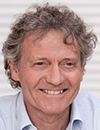Gabor Forgacs,
Professor,
University of Missouri-Columbia; Scientific Founder, Organovo; CSO, Modern Meadow
Dr. Gabor Forgacs is a theoretical physicist turned bioengineer turned innovator and entrepreneur. He is the George H. Vineyard Professor of Biological Physics at the University of Missouri-Columbia, the Executive and Scientific Director of the Shipley Center for Innovation at Clarkson University and scientific founder of Organovo, Inc. and Modern Meadow, Inc. He was trained as a theoretical physicist at the Roland Eotvos University, Budapest, Hungary and the Landau Institute of Theoretical Physics, Moscow, USSR. He also has a degree in biology. His research interests span from topics in theoretical physics to physical mechanisms in early embryonic development. He is the co-author of the celebrated text in the field, “Biological Physics of the Developing Embryo” (Cambridge University Press, 2005) that discusses the fundamental morphogenetic mechanisms evident in early development. These mechanisms are being applied to building living structures of prescribed shape and functionality using bioprinting, a novel tissue engineering technology he pioneered. He is the author of over 160 peer-reviewed scientific articles and 5 books. He has been recognized by numerous awards and citations. In particular, he was named as one of the “100 most innovative people in business in 2010” by FastCompany.
|

|
|

 Add to Calendar ▼2019-06-20 09:00:002019-06-20 10:00:00Europe/LondonTissue Engineering and Biofabrication Beyond MedicineBiofabrication and Biomanufacturing Europe 2019 in Rotterdam, The NetherlandsRotterdam, The NetherlandsSELECTBIOenquiries@selectbiosciences.com
Add to Calendar ▼2019-06-20 09:00:002019-06-20 10:00:00Europe/LondonTissue Engineering and Biofabrication Beyond MedicineBiofabrication and Biomanufacturing Europe 2019 in Rotterdam, The NetherlandsRotterdam, The NetherlandsSELECTBIOenquiries@selectbiosciences.com Add to Calendar ▼2019-06-20 00:00:002019-06-21 00:00:00Europe/LondonBiofabrication and Biomanufacturing Europe 2019Biofabrication and Biomanufacturing Europe 2019 in Rotterdam, The NetherlandsRotterdam, The NetherlandsSELECTBIOenquiries@selectbiosciences.com
Add to Calendar ▼2019-06-20 00:00:002019-06-21 00:00:00Europe/LondonBiofabrication and Biomanufacturing Europe 2019Biofabrication and Biomanufacturing Europe 2019 in Rotterdam, The NetherlandsRotterdam, The NetherlandsSELECTBIOenquiries@selectbiosciences.com